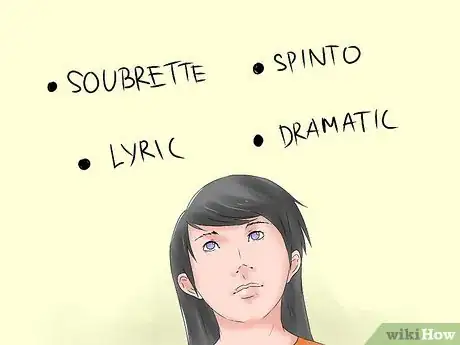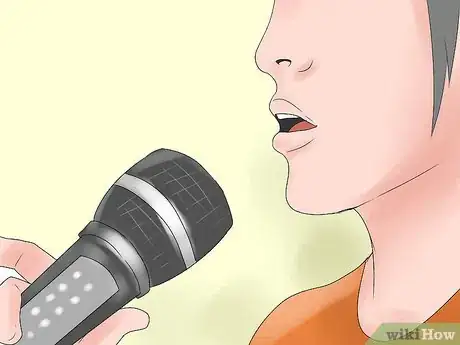X
wikiHow is a “wiki,” similar to Wikipedia, which means that many of our articles are co-written by multiple authors. To create this article, 22 people, some anonymous, worked to edit and improve it over time.
This article has been viewed 126,335 times.
Learn more...
You hear them on the radio all the time - the likes of Mariah Carey, Celine Dion, Whitney Houston, Jennifer Hudson, Jordin Sparks, the list goes on and on. You want to sing like that, but you're not sure where to start. Don't worry! Here you'll learn how to build up your voice so you can belt it out just like they do.
Steps
-
1Get familiar with terminology. "Powerhouse singing" is typically referred to by the general public as belting. Belting, however, doesn't always equal very loud vocals. Belting is a specific vocal style most commonly found in broadway singing. It gives the illusion that the chest voice is carried up very high into the head voice range. Actually, skillful singers must learn to mix the two voices to create a seamless and pressure free tone. Carrying only chest voice as high as it can go will create an over abundance of pressure and cause damage. Chest voice is the voice you typically use to speak in and resonates mostly in your chest. Head voice is the higher, lighter voice most people use when singing very softly and it resonates mostly in your head. For the purposes of this article, we will use the terms "powerhouse vocals" and "belting" interchangeably.
-
2Keep in mind that everyone has a unique vocal timbre, or "color" of voice. In order from lightest to heaviest, they are soubrette, lyric, spinto, and dramatic.
- Soubrette is a term used for both color and range. Soubrette voices are higher toned voices, cutting and resembling the sound of a bell. Often if you are a high belt singer then your head voice will be that of a soubrette. this is because the higher tone you have in your head voice increases the range of the chest voice making it stronger and more powerful.
- Lyric voices are light, but heavier than soubrettes and if their voices are used correctly they will easily overpower Dramatic singers. Lyric singers belt with ease and power, but sometimes the sound might be too thin for some to listen to all the time.(such as http://www.youtube.com/watch?v=-WhtxYxeZ6I&feature=related (Celine Dion), although their voices tend to have a thinner, possibly more nasal sound.
- Spinto is an Italian term that means "pushed." Spinto singers, such as Christina Aguilera, can handle belting at intermittent levels, and typically sound very edgy.
- Dramatic voices are the heaviest and fullest of all vocal timbres. Laura Branigan is generally regarded as having a dramatic vocal timbre, she was able to belt for long periods of time and has an extremely strong resonance. People with dramatic voices can handle long periods of belting and can typically sing over loud orchestras.
Advertisement -
3Once you have figured out your vocal timbre, now's the time to figure out your range. There are three terms to describe range:
- The first is alto (or contralto) and it's the lowest voice of all female voices. Toni Braxton is an alto. Alto voices can typically sing from F3 to F5, although some can go much lower and higher.
- Next there is mezzo-soprano, or "middle soprano." Mezzo-soprano singers can typically sing from A3 to A5, although again, this can vary.
- The highest of the female voices is soprano. Sopranos can typically sing from C4 (also known as middle C) to A5 (also known as high A).
- These definitions are for classical vocalists though, and in pop/modern vocals, these definitions are just an estimate. To test your range, simply go to a piano or keyboard and find middle C. Just about anyone can vocalize a middle C. Sing against that, and see how high you can go above it and how low you can go below it. This will give you a general idea of which term describes your range.
-
4Remember however, range is not everything and certainly doesn't say whether you can be a belter or not. Toni Braxton is an alto which means she has a vocal color that is darker in color than a soprano and is more comfortable singing low (but can certainly sing high) , but she does have a very powerful voice.
-
5Become familiar with mixed voice. Simply put, mixed voice is just what it's called - a mix between chest voice and head voice, lying between those two registers. Learning to sing with mixed voice and strengthening mixed voice takes a great deal of strain off of your voice when belting, and it also enables you to belt even higher. Mixed voice has a tendency to sound slightly nasal because it resonates mostly in the nasal cavity. Don't worry about this. As long as it's only slightly nasal and not excessively so, it's OK.
-
6Now the fun part - belting! Always remember to support your breath very well! If you don't, your belting will be very "pitchy" and generally just not sound good. Relax and trust your voice. Don't try to force it at all. Belting is not something that you can be good at overnight. It takes a lot of practice. Think of it as yelling over music, but don't actually yell! As said before, support that breath! Also, keep good posture. When belting, a good rule of thumb is to make sure you're not tightening your diaphragm up too much. You want your breathing when singing to be more in your stomach than in your chest. When breathing while singing, make sure your stomach is expanding.
-
7Remember to breathe! Some people actually forget to take breaths when belting, resulting in them running out of breath mid-note.
-
8Keep your jaw relaxed. Tightening up your jaw will compromise the sound of your belting, noticeably so.
-
9Remember that not all voices are equipped to belt effectively, and this is OK. Some of the best singers out there can't sing over the sound of bombs, and that's OK. Just like range, power isn't everything. Just work what you have!
-
10The most important thing to remember though is that if it hurts, STOP! Singing should never be a painful experience! If you experience pain while singing, that is your body telling you that you are doing something wrong or pushing it beyond it's limits. You should never be hoarse (or even worse, completely voiceless) after belting through a song, or even a whole set. If you find that you can't belt without pain or a loss of voice, consult with a voice teacher so you can learn to properly belt without risking your vocal health.
Advertisement
Community Q&A
-
QuestionHow can I be selected for an audition if I have a high voice but I can't belt very well?
 Community AnswerWork on perfecting your falsetto. That means when you are singing very high but can't maintain a belt. It is a very soft and beautiful sound.
Community AnswerWork on perfecting your falsetto. That means when you are singing very high but can't maintain a belt. It is a very soft and beautiful sound. -
QuestionSo is belting basically singing in a powerful voice using your diaphragm?
 Community AnswerYes. A powerful voice comes from your diaphragm, and strong throat muscles help with powerful singing. Take a good breath so you can hold your notes longer.
Community AnswerYes. A powerful voice comes from your diaphragm, and strong throat muscles help with powerful singing. Take a good breath so you can hold your notes longer. -
QuestionHow can I do sight-singing?
 Sugarplum PrincessCommunity AnswerSight-singing is an important skill to have as a musician. It is a skill that can be learned and continually improved upon.You can do it by: Familiarizing yourself with a variety of rhythms, memorizing key signatures at one glance and by knowing your scales forward and backward.
Sugarplum PrincessCommunity AnswerSight-singing is an important skill to have as a musician. It is a skill that can be learned and continually improved upon.You can do it by: Familiarizing yourself with a variety of rhythms, memorizing key signatures at one glance and by knowing your scales forward and backward.
Advertisement
Warnings
- This article is simply meant to assist you. Incorrect belting can result in long-term vocal damage, so if you're serious about singing and want to preserve your singing voice, invest in lessons. Your voice will thank you for years to come!⧼thumbs_response⧽
Advertisement
About This Article
Advertisement































































